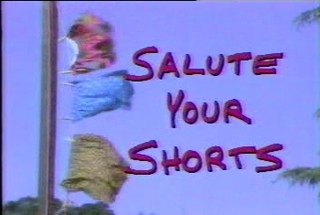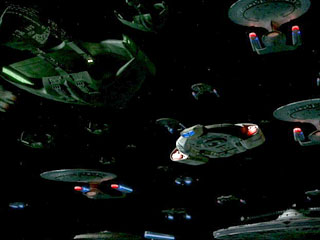
Star Trek: The Next Generation (TNG) is an American science fiction television series created by Gene Roddenberry. It originally aired from September 28, 1987, to May 23, 1994, in syndication, spanning 178 episodes over seven seasons. The third series in the Star Trek franchise, it was inspired by Star Trek: The Original Series. Set in the latter third of the 24th century, when Earth is part of the United Federation of Planets, it follows the adventures of a Starfleet starship, the USS Enterprise (NCC-1701-D), in its exploration of the Alpha quadrant and Beta quadrant in the Milky Way galaxy.
Star Trek is an American science fiction television series created by Gene Roddenberry that follows the adventures of the starship USS Enterprise (NCC-1701) and its crew. It acquired the retronym of Star Trek: The Original Series to distinguish the show within the media franchise that it began.

Star Trek: The Animated Series (TAS) is an American animated science fiction television series created by Gene Roddenberry. It originally aired simply under the title Star Trek, subtitled Created by Gene Roddenberry, on Saturday mornings from September 8, 1973 to October 12, 1974 on NBC, spanning 22 episodes over two seasons. The second series in the Star Trek franchise, it features mostly the same characters as Star Trek: The Original Series. Set in the 23rd century, the series follows the further adventures of the Starship USS Enterprise as it explores the galaxy.
A television pilot in United Kingdom and United States television, is a standalone episode of a television series that is used to sell a show to a television network or other distributor. A pilot is created to be a testing ground to gauge whether a series will be successful. It is, therefore, a test episode for the intended television series, an early step in the series development, much like pilot studies serve as precursors to the start of larger activity.
"The Cage" is the first pilot episode of the American television series Star Trek. It was completed on January 22, 1965. The episode was written by Gene Roddenberry and directed by Robert Butler. It was rejected by NBC in February 1965, and the network ordered another pilot episode, which became "Where No Man Has Gone Before". Much of the original footage from "The Cage" was later incorporated into the season 1 two-part episode "The Menagerie" (1966); however, "The Cage" was first released to the public on VHS in 1986, with a special introduction by Gene Roddenberry, as a hybrid of the color footage that was used in "The Menagerie" and black and white footage which was not used in "The Menagerie". It was not broadcast on television in its complete all-color form until 1988. The black and white version and all-color version were also released in various standard-definition media including LaserDisc, VHS, and DVD formats.

Salute Your Shorts is an American television sitcom created by Steve Slavkin and produced by Propaganda Films, which aired on Nickelodeon from July 4, 1991, to September 12, 1992.

KaBlam! is an American animated sketch comedy anthology television series that ran on Nickelodeon from October 11, 1996 to January 22, 2000, with repeats until November 2, 2001. The series was created by Robert Mittenthal, Will McRobb, and Chris Viscardi. The show was developed as a fully animated showcase for alternative forms of animation that were more common in indie films and commercials. Each episode thus features a collection of short films in different innovative styles of animation, bridged by the characters Henry and June, who introduce the short animations and have zany hijinks of their own in between.
The Little Rascals is a 30-minute Saturday morning animated series produced by Hanna-Barbera Productions and King World Productions. It first aired on ABC on September 25, 1982. A spin-off based on the live-action Our Gang comedy shorts, it was broadcast as part of The Pac-Man/Little Rascals/Richie Rich Show in 1982 and then as part of The Monchhichis/Little Rascals/Richie Rich Show in 1983.
A recap sequence is a narrative device used by many television series to bring the viewer up to date with the current events of the stories' plot. It is usually a short montage of important scenes cut directly from previous episodes, usually short bursts of dialogue, which serve to lay the background for the following episode.
"These Are the Voyages..." is the series finale of the American science fiction television series Star Trek: Enterprise. The 22nd episode of the fourth season and the 98th of the series overall, it first aired on UPN in the United States on May 13, 2005. It is a frame story in which the 22nd-century events of Star Trek: Enterprise are recounted in a 24th-century holodeck re-creation that is folded into the Star Trek: The Next Generation episode "The Pegasus", which aired eleven years earlier. It features guest stars Jonathan Frakes, Marina Sirtis and Jeffrey Combs, as well as a voice cameo from Brent Spiner. Series creators Rick Berman and Brannon Braga, who co-wrote the episode, conceived "These Are the Voyages..." as a valentine to Star Trek fans.
Dynamo Duck was the main character in the children's series The Adventures of Dynamo Duck, which aired on television in the early 1990s.

"What You Leave Behind" is the series finale of the television show Star Trek: Deep Space Nine, the 175th and 176th episodes, the 25th and 26th episodes of the seventh season. The episode was written by showrunner Ira Steven Behr and Hans Beimler and directed by Allan Kroeker. It originally aired the week of May 31, 1999.

The Transformers is an animated television series that originally aired from September 17, 1984, to November 11, 1987, in syndication based upon Hasbro and Takara's Transformers toy line. The first television series in the Transformers franchise, it depicts a war among giant robots that can transform into vehicles and other objects. The series was produced by Marvel Productions and Sunbow Productions in association with Japanese studio Toei Animation for first-run syndication. Toei co-produced the show as the main animation studio for its first two seasons, having been tasked with creating and finalizing animation models, designing transformation schemes, storyboarding some episodes, and general direction. In the third season, Toei's involvement with the production team was reduced and the animation services were shared with the South Korean studio AKOM. The show's supervising producer was also AKOM's founder. The fourth season was entirely animated by AKOM. The series was supplemented by a feature film, The Transformers: The Movie (1986), taking place between the second and third seasons. This series is also popularly known as "Generation One", a term originally coined by fans in response to the re-branding of the franchise as Transformers: Generation 2 in 1992, which eventually made its way into official use. The series was later shown in reruns on Sci-Fi Channel and The Hub / Discovery Family.
"The Chronicle" is an hour-long, two-part episode that constitutes the 177th and 178th episodes of the NBC sitcom Seinfeld. These were the 21st and 22nd episodes of Seinfeld from the ninth and final season. It aired on May 14, 1998. Both parts of "The Chronicle" were seen by 58.53 million viewers. To accommodate the long running time of "The Finale", "The Chronicle" ran for 45 minutes on its initial airing. When rerun it was split into two half-hour episodes, with a new scene added to introduce the second episode. The episode is a clip show containing just a few minutes of previously unseen footage, most of which is bloopers from previous episodes and behind-the-scenes photographs rather than new film.
"Security Hazard" is the 26th episode of Thunderbirds, a British Supermarionation television series created by Gerry and Sylvia Anderson and filmed by their production company AP Films (APF) for ITC Entertainment. The final episode of Series One, it was written by Alan Pattillo, directed by Desmond Saunders, and first broadcast on 31 March 1966 on ATV Midlands. It had its first UK‑wide network transmission on 10 April 1992 on BBC2.

Zoom is an American live-action children's television series in which child cast members present a variety of types of content, including games, recipes, science experiments, and short plays, based on ideas sent in by children, and is a remake of the 1972 television program of the same name. Created by Christopher Sarson, the series originally aired on PBS Kids from January 4, 1999 to May 6, 2005, with reruns airing until September 2, 2007, and was produced by WGBH-TV in Boston.

Star Trek: Short Treks is an American science fiction anthology television series created by Bryan Fuller and Alex Kurtzman for the streaming service CBS All Access. Originating as a companion series to Star Trek: Discovery, it consists of several 10- to 20-minute-long shorts that use settings and characters from Discovery and other Star Trek series.

The first season of the American television series Star Trek: Picard features the character Jean-Luc Picard after he retired from Starfleet following the destruction of the planet Romulus. Living on his family's vineyard in 2399, Picard is drawn into a new adventure when he is visited by the daughter of android lieutenant commander Data. The season was produced by CBS Television Studios in association with Secret Hideout, Weed Road Pictures, Escapist Fare, and Roddenberry Entertainment, with Michael Chabon serving as showrunner.








